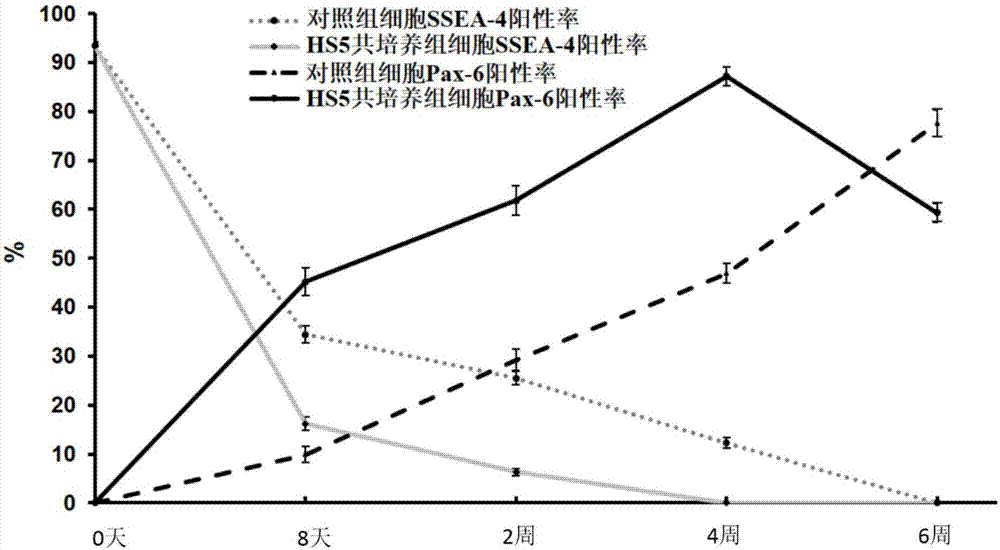Neural cell system obtained by enabling human induced pluripotent stem cells (hiPSC) to differentiate by means of directional induction, and induction method and application of neural cell system
A nerve cell, directional induction technology, applied in the field of neurobiology, can solve the problems of mixed naive cells, insufficient to provide nerve cell lineages, and inability to meet various cell types, etc., to achieve the effect of treating nervous system diseases.
- Summary
- Abstract
- Description
- Claims
- Application Information
AI Technical Summary
Problems solved by technology
Method used
Image
Examples
Embodiment 1
[0077] Example 1 Establishment of co-culture system of bone marrow stromal cell line HS5 and hiPSC cells
[0078] Human bone marrow stromal cell line HS5 (human bone marrow stromal cell line, CRL-11882 TM, American Type Culture Collection (ATCC), Manassas, VA, USA) to induce neural differentiation of hiPSC cells, the composition of the induction medium is: 20% KSR, 1% NEAA, 1 mM glutamine, 0.1 mM β-mercaptoethanol, 10 ng / ml bFGF, 10ng / ml EGF, 10ng / ml BDNF, 10ng / ml NT-3, 2% B27, 0.5mM bisbutyryl cyclic adenosine monophosphate, 1ng / ml transforming growth factor β3 (the above components were purchased from Invitrogen) and 500ng / ml Noggin (R&D Systems, Minneapolis, MN, USA). Among them, the addition of NEAA, bFGF, β-mercaptoethanol and bisbutyryl cyclic adenosine monophosphate is to effectively promote the proliferation activity of cell differentiation products synchronously during the differentiation of stem cells into neural cell lineages; B27 is a serum-free additive ( It m...
Embodiment 2
[0082] Example 2 Three-stage culture of neural differentiation of hiPSC cells
[0083] The first stage: direct co-cultivation of hiPSC cells and HS5 cells for 2 weeks. The composition of the induction medium is the same as that in Example 1. In a six-well plate, hiPSC cells 5 Each / well was directly inoculated on 2 × 10 pre-plated 1 day before 5 cells / well on the HS5 cell layer; for the parallel control group, hiPSC cells were not co-cultured with HS5 cells, but were directly inoculated into Matrigel-coated 6-well plates, and then cultured in the second and third stages by the same method. Change the solution every other day.
[0084] The second stage: continuous culture with 1:1 diluted HS5-CM medium for 2 weeks; preparation of HS5-CM medium: 1×10 7 HS5 cells were irradiated and inoculated into a culture dish containing 10ml hiPSC induction medium, and the waste liquid was collected every day for 4 consecutive days to obtain HS5-CM medium. Before use, the collected HS5-CM w...
Embodiment 3
[0086] Example 3 Direct contact co-culture activates the Notch signaling pathway in hiPSC cells
[0087] In view of the fact that the Notch ligands Delta1, delta3, Jagged1 and Jagged2 can be easily detected in HS5 cells by using the "reverse transcription PCR" method in the experimental method ( figure 2 a), while the Notch corresponding receptors Notch1, Notch2 and Notch3 can be detected in hiPSC cells and their derivatives ( figure 2 b), It is speculated that the Notch signaling pathway mediates the interaction between HS5 and hiPSC cells. The NICD protein dissociates from the Notch receptor after being acted on by γ-secretase, and targets the downstream molecules Hes1 and Hes5. After induction of differentiation for 8 days, the expression level of NICD protein in hiPSC-derived cells in each group was detected by using the "Western blot analysis" method in the experimental method. The results showed that the direct contact co-culture group was significantly higher than t...
PUM
 Login to View More
Login to View More Abstract
Description
Claims
Application Information
 Login to View More
Login to View More - R&D
- Intellectual Property
- Life Sciences
- Materials
- Tech Scout
- Unparalleled Data Quality
- Higher Quality Content
- 60% Fewer Hallucinations
Browse by: Latest US Patents, China's latest patents, Technical Efficacy Thesaurus, Application Domain, Technology Topic, Popular Technical Reports.
© 2025 PatSnap. All rights reserved.Legal|Privacy policy|Modern Slavery Act Transparency Statement|Sitemap|About US| Contact US: help@patsnap.com



